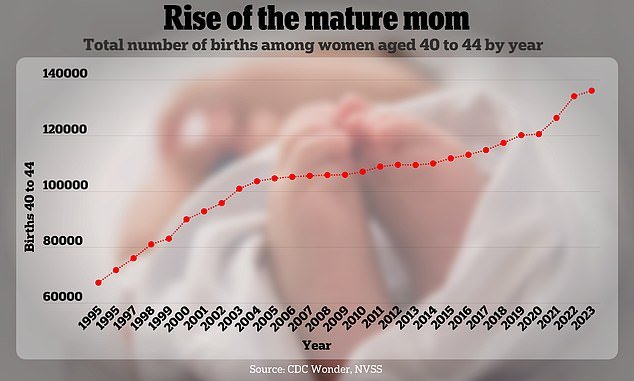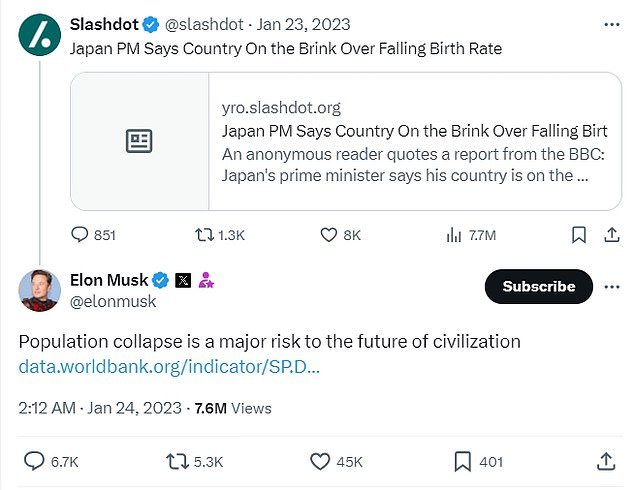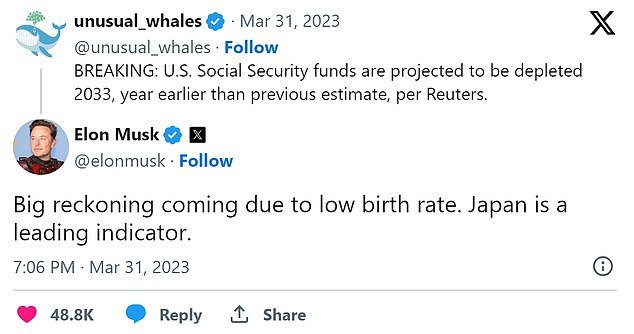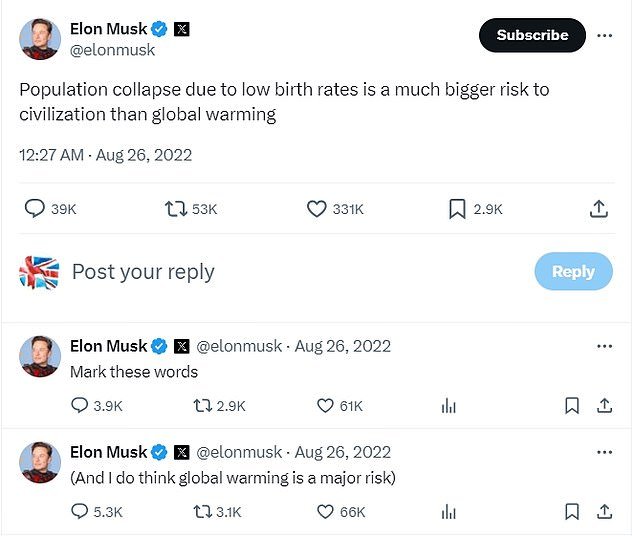Panic as US birth rates fall to lowest level in 100 years… as top researcher labels fertility crisis a ‘fire that threatens our survival’
Experts have warned of a ‘smoldering fire that threatens our survival’ after fertility rates fell to the lowest levels in a century and since records began.
The latest data from the CDC released yesterday shows that only 3.6 million children were born in the US last year, a two percent decline from the year before.
This brings the fertility rate down to 1.62 births per woman in 2023 – the lowest since the government started recording this measure in the 1930s, when it was 2.1 births.
The decline is raising alarm over the shrinking workforce and shrinking pool of taxpayers – putting many communities at risk.
Social Security – which pays for pensions – is expected to run out of money within a decade, while a key Medicare trust fund could be empty by 2031.


Dr. Jay Richards warned this was a “smoldering crisis.” And Elon Musk, pictured above in an AI-rendered image, has repeatedly warned about the risks of depopulation
There are also warnings that the shift will force a complete reorganization of society as more of the population ages and can no longer work.
One public figure who has predicted chaos associated with low birth rates is businessman and X CEO Elon Musk, who has previously noted that declining fertility rates pose a greater threat to humans than climate change.
Following the release of the latest figures, Dr. Jay Richards, a research associate at the DC-based Heritage Foundation, told X: “This is not a burning political issue at this point.
“But it is a smoldering fire that threatens the future survival of our culture.”
Dr. Natalia Bhattacharjee, a population researcher at the University of Washington, added last month: “The implications are enormous.
“These future trends in fertility rates and live births will completely reconfigure the global economy and the international balance of power and will necessitate reorganization of societies.”
A report published last month also warned of the risks, saying middle- and high-income countries faced significant economic challenges as they faced a shrinking workforce.
The latest data was released by the National Center for Health Statistics (NCHS) and is based on an analysis of more than 99 percent of all births in 2023. But the figures are preliminary and more data is expected in the coming months.
The fertility rate for 2023 was two percent lower than the almost 1.7 births per woman the year before.
It also marked the 15th consecutive year that the U.S. birth rate has been below the replacement rate — or the rate needed to keep the population at the same level — at 2.1 births per woman.
The record was set in 1957, when each woman had an average of 3.7 children, according to official figures.
In terms of birth rates, it appeared that they had fallen most among mothers in their 20s and 30s.
For the 25 to 29 age group, this figure had fallen to less than one million per year.
There were also a record number of births among people over the age of 40, with 136,100 births recorded among people aged between 40 and 44 – an increase of two percent in one year.
Experts say fewer people are having children as America’s younger generations prioritize careers, travel and their social lives over having babies.

There has also been an increase in the number of births among women over 40 years of age



Others have also expressed concerns about rising costs of living and student debt, which they say is leaving many feeling financially unable to start a family.
An increase in births among older adults has been attributed to greater availability of IVF and egg freezing technologies.
Dr. Brady Hamilton, a statistician at NCHS and lead author of the new report, shared CNN: ‘Decrease fits in with the general pattern (for births).
‘The highest figures have shifted over time to women in their 30s, while previously these were women in their 20s.
‘One factor is of course the ability to wait.
“We’ve had a pandemic, or there’s an economic downturn, let’s say – women in their 20s can delay childbirth until the situation improves and they feel more comfortable.
‘For older women, waiting is not very feasible.’
There are also concerns that the Joe v Wade decision could impact births in the US due to concerns about access to care.
The current strategy in middle and high-income countries is to use migration policies to cover up the cracks caused by shrinking populations.
Plans such as longer maternity leave, higher wages and tax breaks for people with children are likely to lead to only a small increase in the birth rate, experts say.
